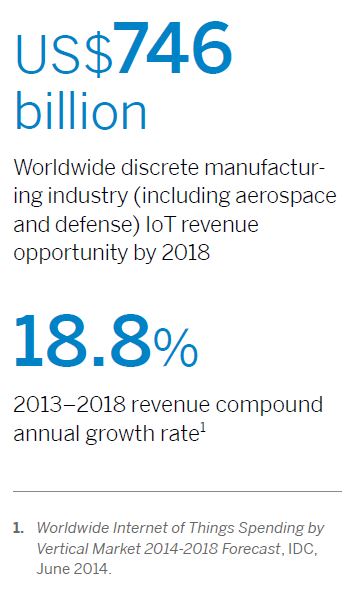
In the aerospace and defense (A&D) industry, split-second decisions can mean the difference between success and failure.
Unlike some industry sectors that are early in The Internet of Things (IoT) maturity spectrum, A&D companies have been successfully implementing sensors and computerized automation for decades in their manufacturing operations and products. So what´s so new with IoT? How will it create an impact for aerospace companies?

The IoT will redefine not only manufacturing processes but also what a product is. It will change global competitiveness with increased colocation of design, manufacturing, and services.
The following four top priorities need to be considered when building or improving on a successful IoT strategy.
The connected factory
As machines and robotics become smart and communicative, production units will become more active, autonomous, and selforganizing. Machines and robotics will make decisions together about tools, parts, and production steps. Machines will report their status to manufacturers’ enterprise resource planning systems. With a real-time view of production, plant managers will be able to react quickly if problems occur.
The connected aircraft

Adding sensors to the “smart” equipment OEMs produce opens huge opportunities for hardware design improvements and new service offerings. New IoT technologies bring capabilities such as:
- Real-time response to quickly diagnose and act on operational disruptions
- Condition-based maintenance and prognostics to detect trends and conditions before they lead to failure
- Reliability programs to build long-term strategies to improve equipment reliability
- Performance-based logistics to expand insight into equipment performance
Connected people
As machines become smarter, production lines can be enriched and humanized. Workers can be assigned as needed to coordinate automated production processes and intervene when machines call for action. New ways of working will emerge. For example, smart glasses and 3D visualization can help workers fulfill tasks without long training sessions. Maintenance technicians can get visual instructions and historical data from machines on their mobile devices.
The connected supply chain
Complex global supply channels have contributed to an increase in counterfeit products. Many countries have enacted serialized traceability directives to prevent fraud, particularly in A&D. IoT technologies allow complete visibility into the location and condition of serialized products over their lifecycle.
Use of auto-ID technologies supports improved data quality and transparency. You can expect more efficient operations with automated data discovery and processing, and higher customer satisfaction with faster, more accurate shipping and handling.
Are you ready for the IoT in aerospace and defense?
The IoT is not a distant concept for future consideration. The time to think about the IoT is now.
Learn more about IoT for Aerospace & Defense. Download the CEO Perspective of IoT for Aerospace & Defense to find out more innovations available for this industry today.
Please visit www.sap.com/aerospace/bigdata or follow us on Twitter @sapindustries for the latest updates on SAP Industries news, insights, and events.
Note that this post originally appeared on SAP Business Innovation
